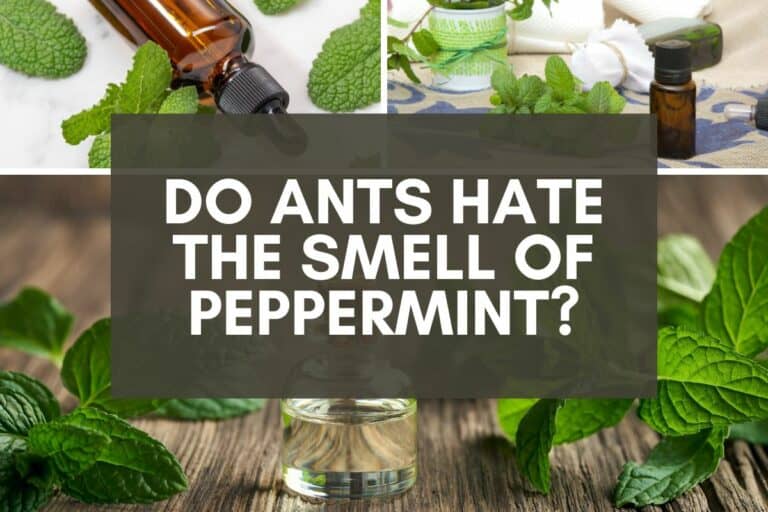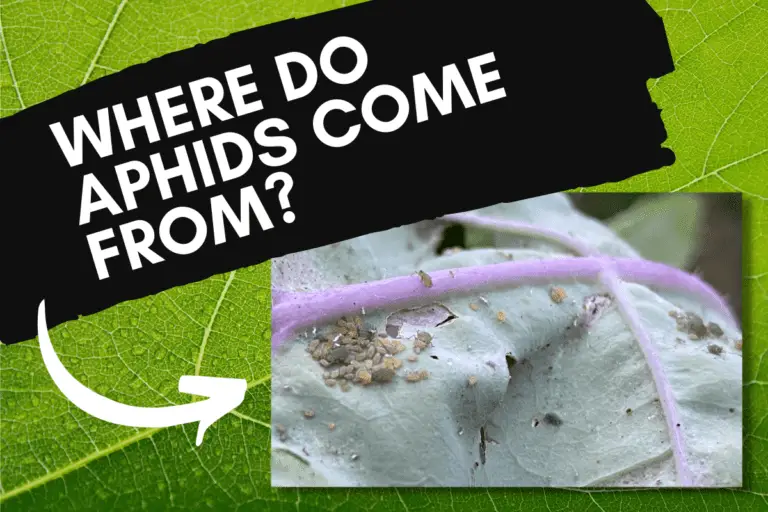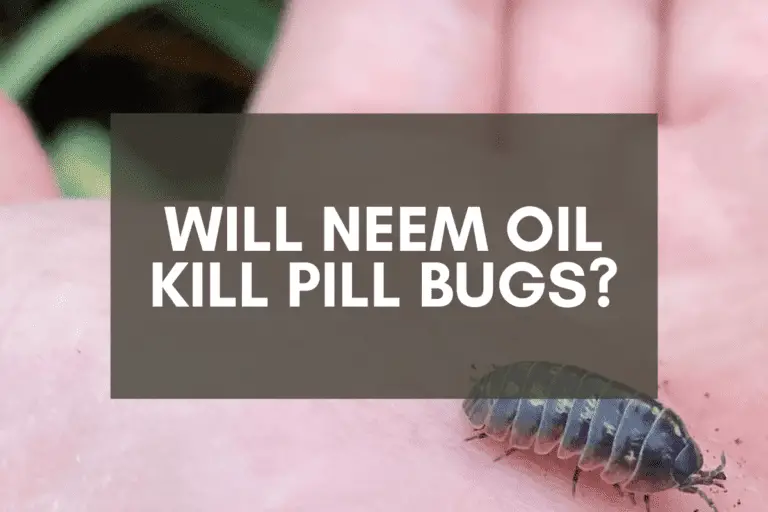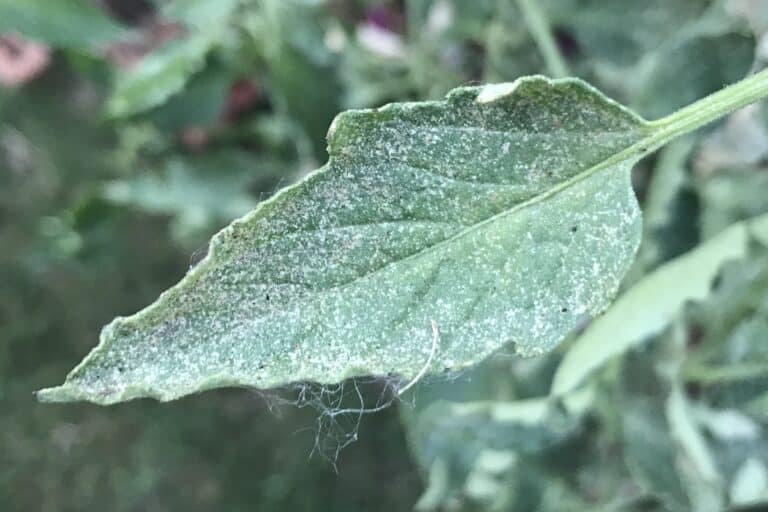Are Aphids Red? Identifying and Stopping Red Aphids
Have you ever noticed small red bugs on your plants and wondered if they were aphids…or something else. Are aphids ever red? And if so, what can you do about them?
Aphids come in many colors–black, green, white, brown, yellow, purple, and pink–but numerous aphid species are dark red, brownish red, pinkish red, and other reddish hues. Red-hued aphids can transmit a number of viruses, including plum pox, rose mosaic virus, and chrysanthemum vein mottle virus.
Red aphids are known for infesting a wide range of plants, and one of the things I’ve seen people struggle with is Identifying them correctly and knowing what to do once red aphids first appear.
I’ve written this article to help you correctly identify red aphids and stop them quickly before they reproduce, damage your plants, and lay eggs that will overwinter in your garden, paving the way for future infestations.
Are Red Aphids Harmful?
I’ve seen some people take a rather lackadaisical approach to aphid infestations. For them, it’s not that big a deal because, unlike other pests, aphids don’t cause much in the way of immediate damage, so they’re not really something to worry about.
Early on in my gardening career, I felt the same, but I now view things differently.
Red aphids are harmful for several reasons. First, they suck the sap out of plants, resulting in stunted or decayed plant growth. Second, they leave a sugary residue behind that kills plant foliage and attracts unwanted ants. Finally, they spread disease from plant to plant and property to property.
Before we get into the details of identifying and getting rid of aphids, here are a few of the many reddish-hued aphids that can be found around the world:
| Name | Species | Color | Size |
|---|---|---|---|
| Campion Aphid | Brachycaudus lychnidis | Dark Red | 2-3 mm |
| Chrysanthemum Aphid | Macrosiphoniella sanborni | Reddish Brown | 1.5-2.5 mm |
| Common Periphyllus Aphid | Periphyllus testudinaceus | Dark, Reddish Brown | 2-3.7 mm |
| Ivy Aphid | Aphis hederae | Light to Dark Reddish Brown | 1.4-2.5mm |
| Plum Thistle Aphid | Brachycaudus cardui | Brownish Red, Green, or Yellow | 1.8-2.4 mm |
| Rose Aphid | Macrosiphum rosae | Reddish Brown, Pink, Green | 1.7-3.6 mm |
| Rosy Apple Aphid | Dysaphis plantaginea | Pinkish Red, Reddish Brown, Gray | 2.1-2.6 mm |
| Variegated Oak Aphid | Lachnus roboris | Brownish Red | 2.5-5.5mm |
As you can see from the information above, aphids are small enough to avoid early detection but large enough to see easily once they grow in number and begin clustering around the flowers, buds, and leaves of plants.
To understand how much damage aphids can cause, let’s start with how they reproduce and spread, then examine the 3 primary ways that they’ll destroy your plants.
Aphids have six legs, and female aphids will produce wingless nymphs in the spring and summer months. But as fall arrives, and as food sources run scarce, female aphids will produce winged aphids so that the wind bugs can fly from their host plant to a new plant to start the reproductive cycle all over again.
If you’d like to know more about the shockingly strange ways that aphids reproduce and travel from place to place, check out my article that looks at where aphids come from and how they spread. Trust me, these are disturbingly creative little pests!
Now let’s look at the kinds of harm they cause:
Sucking Sap: When aphids first invade, they’ll find a preferred plant and pierce the plant’s epidermal layers with their mouthparts (called “stylets”). Puncturing the plant, they seek out its sap (i.e. the organic nutrients that flow throughout the plant) and begin siphoning them off. Like little plant vampires, they’ll literally drain the plant of the energy it needs to thrive, and over time, you’ll begin to notice patchy areas and yellowing, decaying foliage.
Honeydew: As aphids gain a foothold in your garden and start feeding on your plants, they’ll secrete a sugary substance called honeydew, which does two things.
First, honeydew can often provide the perfect environmental condition for the growth of sooty mold, a fungus that leaves dark, ugly-looking spots across a plant’s leaves. Second, honeydew attracts ants, which work diligently to protect the aphids by killing off ladybugs, lacewing larvae, parasitic wasps, and other beneficial predators.
Disease: Most importantly, aphids are vectors for plant-to-plant disease transmission. Rose aphids can transmit rose mosaic virus. Chrysanthemum aphids can spread both Chrysanthemum Vein Mottle Virus & Chrysanthemum Virus B.
But if you spot aphids in your garden, you won’t be able to tell which kind you’ve got (unless you catch a few and send them off to a lab for analysis). In other words, you won’t know what diseases might be spread by the aphids in your garden since aphids can literally transmit hundreds of them.
These 3 reasons are why I take aphid infestations seriously. Even if they can’t do immediate damage to my plants, they can reproduce quickly, suck the life out of my plants, attract unwanted bugs to my garden, and spread who-knows-how-many different diseases.
But here’s some good news: With the exception of a single aphid species that’s only found around the Sun Moon Lake in central Taiwan, aphids can’t harm humans and can’t hurt dogs or other animals.
So unless you plan on strolling around the Sun Moon Lake, you don’t have to worry about aphids doing any harm to you or your furry friends.
How Do You Get Rid of Red Aphids?
In my article on whether or not to throw away aphid-infested plants, I’ve recommended 3 ready-made aphid-killing products: Captain Jack’s Dead Bug Brew, Bonide Rose RX, and Diatomaceous Earth (which I reserve for extreme infestations).
But if you’re looking for the most cost-effective solution to your aphid problem, you’ll want to try something else.
The best way to get rid of red aphids is to spray them on consecutive days with neem oil and insecticidal soap sprays. Spraying neem oil once every 4-5 days, with insecticidal soap sprayed every day in between, will hinder aphids’ biological process and ensure that they can’t feed and reproduce.
When it comes to neem oil, all you need to make a powerful homemade insecticide is a 1- or 2-gallon sprayer, a neem oil concentrate, and a soapy emulsifier. For the insecticidal soap spray, you only need to combine a soapy product with water.
Here’s how I make each:
Neem Oil Spray
- Purchase a 1-gallon or 2-gallon sprayer from any online retailer or home improvement store. The cheap ones will work just fine, but I prefer some of the mid-tier models.
- Fill the bottle with water.
- Add 2 tablespoons of neem oil concentrate per gallon of water. These are the brands I prefer: Verdana Neem Oil and Neem Bliss.
- Add 1 tablespoon of soapy emulsifier per gallon of water. I’ve used these 3 kinds of soap, and they all work great: Dr. Bonner’s (a castile soap), Mrs. Meyers (an organic dish soap), or Safer Brand (an insect-killing soap).
- Shake the bottle to ensure all ingredients are thoroughly mixed, then spray the plant, making sure to thoroughly spray the undersides of all leaves.
Insecticidal Soap Spray
For the insecticidal soap spray, follow the same directions as above except omit step 3. Be sure to add the water first, then the soap. If you add the soap first to your sprayer, you’ll create a ton of foam when filling the rest of the sprayer with water.
Also, you can use Dawn if you’ve got nothing else in your kitchen, but I generally don’t recommend that product since it has grease-cleaning chemicals in it that I don’t necessarily want in my garden. Organic dish soaps are readily available and relatively inexpensive, so I typically buy those and set them aside for use in my insect-killing sprays.
To aggressively attack your aphid infestation, you’ll want to do the following for the next 1-2 weeks:
| Day 1 | Neem Oil Spray |
| Day 2 | Insecticidal Soap Spray |
| Day 3 | Insecticidal Soap Spray |
| Day 4 | Insecticidal Soap Spray |
| Day 5 | Neem Oil Spray |
| Day 6 | Insecticidal Soap Spray |
| Day 7 | Insecticidal Soap Spray |
| Day 8 | Insecticidal Soap Spray |
| Day 9 | Neem Oil Spray |
| Day 10 | Insecticidal Soap Spray |
| Day 11 | Insecticidal Soap Spray |
| Day 12 | Insecticidal Soap Spray |
| Day 13 | Neem Oil Spray |
| Day 14 | Insecticidal Soap Spray |
You might not need to follow this treatment plan for 14 days, so just keep an eye on your plants each day before spraying. And please remember that consistency is key. In fact, I recommend setting a daily alarm or using a calendar to remind yourself not to miss a treatment.
One word of caution: Neem oil should only be applied in the late afternoon or early evening. If you apply it in the morning or early afternoon, you might burn your plants during the heat of the day.
What Colors Are Aphids?
As I noted above, aphids come in a wide variety of colors. Some of the more common are black aphids, green aphids, white or whitish-green aphids, red or brownish red aphids, gray aphids, and all kinds of yellow, purple, and pinkish aphids.
There are more than 4,000 species of aphids spread across 6 continents, so it’s no wonder that there’s lots of variety when it comes to individual aphid populations.
Are Aphids and Spider Mites the Same Thing?
Here’s the thing about aphids and spider mites. They’re both somewhat small, they’re both found on the undersides of leaves, and they’re both capable of sucking the nutrients out of plants. However, that’s where any similarities end.
Aphids and spider mites are entirely unlike each other. Aphids are 3x to 6x larger than spider mites and come in a wider variety of colors than the black, brown, and red that are typical of spider mites. They have six legs, secrete sugary honeydew, and reproduce both asexually and sexually. Aphids transmit plant diseases and often cluster around buds and new flowers, and female aphids produce winged versions of themselves that are capable of flying and seeking out new food sources.
Spider mites are much smaller than aphids and thus very difficult to see with the naked eye, requiring magnification to make out any of their particular features. They have eight legs, they hide and feed on the undersides of foliage (creating a stippling effect on leaves), and they spin wispy webs when food runs scarce, which allow them to travel from plant to plant.
Here’s a photo that I took recently, showing a Red Russian kale with both aphids and spider mites on the underside of the leaf.
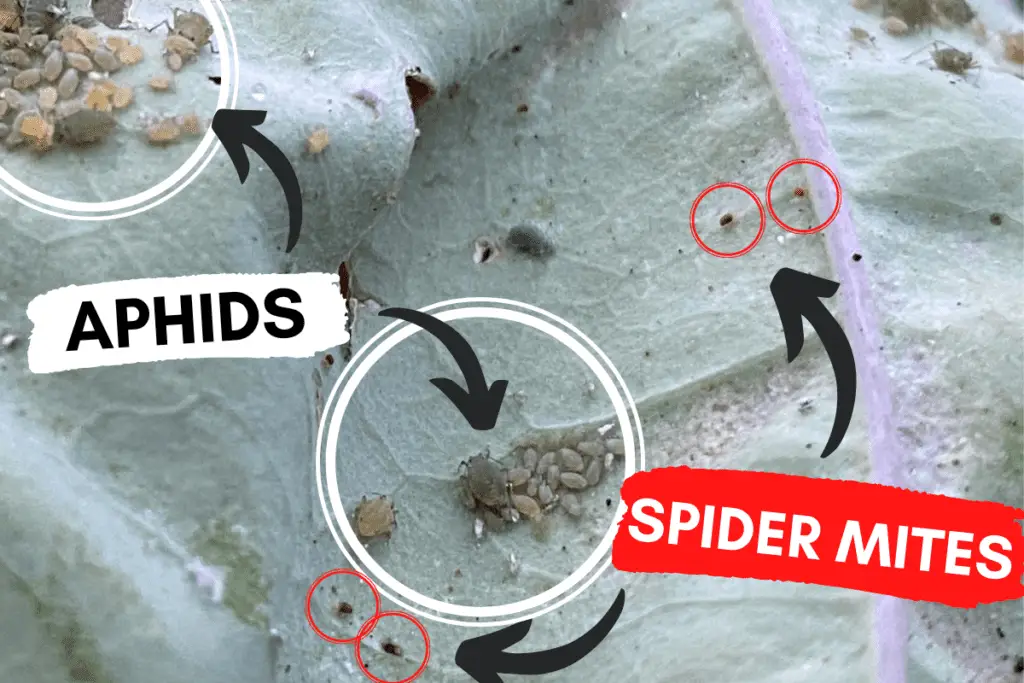
As you can see, the spider mites are around 1/3 the size of the smallest aphid nymphs and less than 1/10 the size of an adult aphid. If you look closely enough, you can see the antennae and legs on several adult aphids, but in this photo–and when you’re looking closely at your plants–you’ll notice that spider mites appear as small spots.
If you take a second look at the featured photo at the very top of this article, you’ll notice that those aren’t aphids but spider mites in the photo, which is why I wanted to show a side-by-side photo here that would make the differences much clearer.
Please remember that if you notice aphids in your garden–and especially if those aphids are accompanied by spider mites–be sure to act immediately. The last thing you want is for those bugs to spread diseases and produce winged versions of themselves that’ll fly to other areas of your property (and beyond).
Special thanks to the folks at Influential Points for providing insights about the lengths of particular aphid species.

